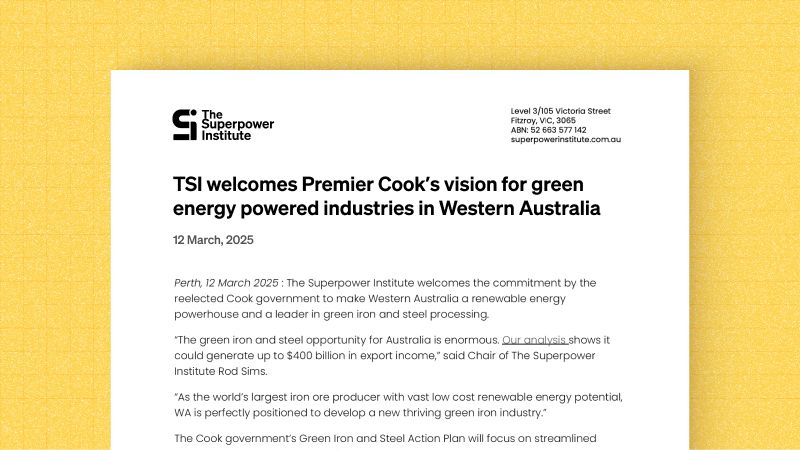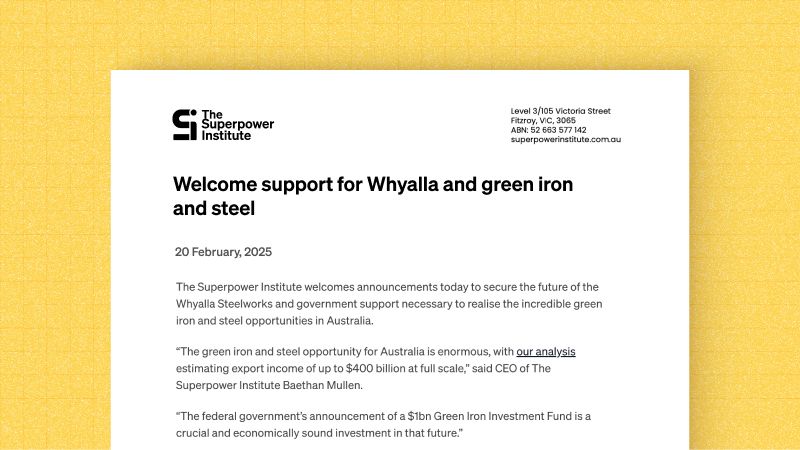Australia’s enormous green metals opportunity
The Superpower Institute (TSI) welcomes the opportunity to contribute to the Department of Industry’s Green Metals consultation process.
This submission sets out TSI’s positions on how to unlock Australia’s enormous green metals opportunities. With the right policy settings addressing key market failures Australia could be exporting 10 million tonnes of green iron by 2030. Along with other green metals opportunities, development of these industries can underpin prosperity in Australia for decades to come and make a significant contribution to global carbon emissions reduction.
TSI’s answers to the questions posed in the consultation paper are also attached to this submission.
The scale of the opportunity
The scale of this opportunity for Australia is immense, with the potential to secure a long period of high investment, rising productivity, full employment and rising incomes in Australia.
We estimate the annual export value of green iron to be $295 billion, or three times the current value of iron ore exports. Green aluminium exports could be worth an additional $60 billion, compared with the current value of bauxite and alumina exports of $10 billion.
Australia’s comparative advantage
Australia possesses two key comparative advantages that position it uniquely to take advantage of green metals opportunities:
- Abundant low cost renewable energy, in the form of high quality wind and solar resources across an expansive geography
- Abundant bulk mineral resources as the largest (or one of the largest) producers of iron ore, bauxite, copper and many other rare/critical minerals
While other countries around the world have a combination of these endowments to varying extents, none match Australia.
Executives in the two largest investors in European green iron plants—ArcelorMittal and H2 Green Steel—have both remarked that Europe will not be able to produce most of its own green iron. Instead, Europe must:
[m]ake the green iron where the electricity is cheaper and then ship the green iron to where you have the steel plants, where you have the know-how and the existing infrastructure.
This is true of most of Australia's major trade partners: they do not have enough cheap renewable energy resources to meet their future needs. China, India, and the EU have some quality renewable resources, but the scale of future electricity demand means that those resources will be exhausted and marginal prices will rise. Japan and South Korea confront starker shortages, and already have among the highest renewables prices in the world.
Australia's high-quality renewable energy resources vastly exceed its future domestic needs. This leaves a practically unlimited surplus available for exploitation by export industries. The most efficient way to export cheap renewable energy to the world will be by embedding it in value-added products such as green metals.
Obstacles to the green metals opportunity
In a well-functioning market, profitability is aligned with social return. Market actors allocate capital to activities with the highest private returns, and in doing so maximise social returns and so real economic growth.
In Australia, investments in green metals are currently unprofitable. This is a consequence of profound market failures that are well-characterised in standard economic theory. Failure to address these market failures will result in costly resource misallocations, and greatly diminish the Australian standard of living.
These market failures are of three main types:
- The non-pricing of CO2. The lack of a global carbon price is an enormous market distortion. Carbon emissions are a negative externality, imposing large costs on society that emitters currently do not bear. Steel and aluminium production using fossil fuels are responsible for more than 10% of world carbon emissions. The costs imposed on society by these emissions are not borne by producers, nor reflected in the prices of these products to customers. This makes it impossible for green manufacturing processes to compete on a level playing field and to deliver economically efficient and zero carbon supply of metals.
- Innovation spillovers. Innovators and early-movers pay large capital costs, and take on large risks, to generate knowledge and expertise that largely benefits other players. Investments in this area therefore create positive externalities. The size of the innovation market failure is proportional to the future social return from innovation. Because Australia’s potential future income from green metals is so large, the innovation spillover is very large. It compounds with the non-pricing of CO2 market failure to further reduce the return to investments in green metals processing.
- Common infrastructure spillovers. Regions with the greatest potential for efficient, large-scale green metals production will usually lack adequate transmission, and infrastructure for transporting and storing inputs such as green hydrogen. It is not profitable for a single private entity to provide these at efficient scale, and many of the benefits of increased regional economic activity cannot be captured by a single entity. Common user, or consortia, approaches and/or government support are likely to be necessary.
In addition to these market failures, a fourth potential obstacle is in the decarbonisation strategies adopted by our major trade partners. Steel and aluminium are essential materials for major industries and for economic development. Current “brown” metal producers around the world are exploring options for reliable supply. This includes extremely costly approaches for retaining a domestic industry (e.g. importing ammonia for injection into blast furnaces), and the possibility of imports from our competitors (e.g. Brazilian ores processed in the Middle East).
Australia must position itself as a credible partner. Our investments in supply will shape the expectations, and so the investments and decarbonisation strategies, of our trade partners.
Finally, we must ensure that Australian production satisfies the requirements of partners’ green trade schemes, such as the EU’s Carbon Border Adjustment Mechanism (CBAM).
Our policy recommendations
This leads to TSI’s four pillars for an efficient policy response to the green metals opportunity:
- pricing the negative externality (CO2 emissions);
- subsidising the positive externality (innovation);
- Government provision of natural monopoly infrastructure; and
- active international diplomacy to secure green premia
Many of TSI’s responses to the consultation paper questions relate to these four pillars. Each of our policy recommendations is important, but the first pillar of carbon pricing (or alternatives to deal with the externality of carbon emissions), the second of innovation support, and the third relating to infrastructure are high priorities to deal with very significant market failures. It is worth briefly describing TSI’s approach here.
Carbon pricing
Australia should impose a carbon price on emissions or an equivalent mechanism. TSI advocates for the Carbon Solutions Levy (CSL), to be introduced by no later than 2030. The CSL would apply at all fossil fuel extraction sites in Australia (around 105 sites) and on all fossil fuel imports into Australia.
Fossil fuel firms will remain profitable. By way of comparison, the Middle East's average tax rate on oil producers is 85%, and the Middle East retains an oil industry. What these fossil firms have in common is a return on capital vastly in excess of the market rate—i.e large economic rents. Two centuries of economic theory tells us that rent taxation is the most efficient and least distortionary form of taxation.
That part of the tax that does not fall on rents will flow through to consumers. Proceeds from the CSL would be more than sufficient to compensate or indeed over-compensate consumers through energy bill and fuel excise relief, and to fund the complementary green industry policy initiatives outlined in this section.
Global policies to efficiently price carbon emissions to deal with this negative externality are fundamental to unlocking green metals export opportunities. This will ensure different technologies compete on merit, having regard to the differences in the level of costs imposed on society by their respective carbon emissions (or lack thereof).
In Australia, until a policy such as the CSL is implemented, the government should provide for second-best carbon price surrogates, in the form of subsidies for crucial parts of the green value chain. The Hydrogen Production Tax Incentive of a $2/kg for renewable hydrogen (H2) is well targeted and supported by TSI. It will be of particular benefit to green iron production. A renewable energy subsidy, akin to the soon-to-expire RET, is another essential surrogate. It will be of particular benefit to green aluminium production, which mainly depends on low cost electricity.
Innovation grants/credits
An efficient approach to innovation grants or credits will be market-based: firms choose projects and retain a large stake in project outcomes. Grant criteria should be general and transparent, with grants made available to any serious project that meets the criteria.
Up-front capital contributions have the highest impact. This may take the form of a grant or a tax-based mechanism, with these being financially equivalent with the right design. For a taxed-based mechanism, we suggest immediate expensing of capital expenditure, an uplift on CAPEX for tax deductions, and allowing credits to be cashed out if the taxpayer has no taxed income against which it can be deducted.
For the first few commercial projects in a given technology category, we suggest capital grants of 50% or equivalent tax credits. Grants (or tax credits) thereafter should receive diminishing support on a sliding scale towards zero as the number of projects reaches a certain level. It may be appropriate to impose payment floors and ceilings. In terms of grant size, the design has similarities with the US Industrial Demonstrations Program, a US$20+ billion program that contributes up to 50% of the costs of innovative green industrial projects. Payments are capped at US$500 million, and the minimum size is US$35 million. If implemented through the tax system, the design is closely related to the R and D tax credit currently in operation.
Grants should be applied to the component of the project that requires innovation (where innovation includes bringing a technology to scale in Australia for the first time). For example, in a project with hydrogen electrolysers, a hydrogen direct-reduction-iron (DRI) plant, and renewable energy, the electrolysers and DRI are new to Australia and should attract the incentive. The renewable energy component should not be supported by innovation grants/credits, but it may be supported by renewable energy-specific mechanisms.
Government funded natural monopoly infrastructure
The third market failure to address is in supporting the essential infrastructure that will underpin investment and green metals production. We do not want a lack of ready infrastructure, or excessive costs, holding back development. Government should fund new natural-monopoly infrastructure that is essential for green iron, steel, and other green exports, to ensure low prices and to ensure that infrastructure gaps are not a barrier to private investment. In particular, the government needs to build ahead of demand.
The Government can, of course, recover its costs of infrastructure provision at a government discount rate through a government business enterprise which would be off budget. Further, it will be more economically efficient to have this infrastructure funded by government rather than the private sector where regulatory settings often see returns allowed which impose high costs on users.
An achievable target by 2030
We note that responses in this document mainly relate to the green iron/steel opportunity, with some comments on the simpler case of aluminium. However, similar principles apply to other metals processing which may be covered by the 10 percent production credit for critical minerals.
With the policy recommendations we suggest in place, an ambitious but achievable target for green iron would be 10 million tonnes by 2030.
The remainder of this submission addresses the questions posed in the consultation paper.
The Superpower Institute's submission to the Senate Standing Committee on Economics inquiry into the Future Made in Australia Bill.


